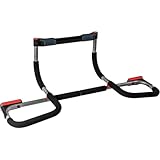Home Exercise Machines - What Kind Is The Best Exercise Machine For You?
Home Exercise Machines - Filling The Gap.
Most homes have some kind of home exercise machines, and all too often they're quietly gathering dust in a corner of the spare room. An exercise bike, or maybe a treadmill, bought on a whim, used twice, then condemned to be an impromptu laundry stand forever more. When the gym is not an option, for whatever reason - maybe it's the thought of the commute, or the ever increasing fees - then home exercise equipment can fill the gap. The hard part comes when you're juggling budget and space requirements with the dream set-up in your head. Most of us have to compromise.
Best Investment In Your Fitness?
But you want to keep in good shape, and you want to do it in the comfort of your own home. What's the best investment you can make for the sake of your fitness and your continued good health? How do you guarantee your particular home exercise machine won't be exiled to the spare room after a trial run, a bulky, awkward nuisance that nobody wants to take off your hands and is far too expensive to take to the dump?
Best advice? Pick an exercise machine that does something you enjoy. If you'd usually go out for a run, but the weather's just too bad, get a treadmill. If your gym got too expensive, get your own gym equipment - buy a bench and a set of free weights. Stick to what you know and what works.
What Kind Of Exercise Do You Need?
Start by asking what kind of exercise you need. The three areas you can focus on are cardiovascular health, resistance training, and flexibility. Let's start with cardio training. And the best exercise equipment you can buy for this is a good pair of running shoes. The rest - tracksuit, stopwatch, treadmill - can go by the board. With a decent pair of running shoes, you're all set.
If you run indoors, you need a treadmill. It's a big investment, and as with all home exercise machines, buying by price is usually a false economy. I've watched a gym owner spend hours repairing professional quality kit. It was all superbly made, but took a relentless pounding day after day, and metal fatigue eventually did the damage. Buy one knowing that eventually you'll wear it out. But then it'll still be a good laundry stand.
Treadmills come in two flavours: the non motorized ones, which are basically foot powered and offer no frills running on the spot, and the motorized kind that offers programmes and perhaps even heart rate monitoring, along with various levels of incline to simulate running uphill. All treadmills have a maximum speed, and if you're just starting out then something that peaks around 12kph/ 7.5mph is probably fast enough. The controls, accessed through an LCD screen in the console, allow you to set the speed anywhere from slow walking pace to flat out
running, and change this speed in real time.
Exercise Bikes
Exercise Bike
If you're not into running but still want a cardio option, an exercise bike is your best bet. It takes up as much space as an ordinary bicycle would, and it's not something you want to be humping around every time you want to use it, so it's important to have a space where it can both stand and be used, undisturbed. Not a problem if you work out in the spare room, more so if you like to watch TV in the lounge while doing it. The best featured models have adjustable degrees of resistance, to make your workouts harder, and perhaps a heart rate monitor to make sure you don't overdo it. A programme option will enable you to set particular challenges.
Cross Trainers From Amazon:
Cross Trainer Or Elliptical.
If neither of these cardio options appeals, then consider a cross trainer or elliptical trainer. These home exercise machines provide a low impact workout to tone your upper body and legs at the same time, while flexing your stomach and sides with gentle twisting movements. This burns calories, making cross trainers an ideal way to lose weight. The range of movement builds flexibility, and a couple of sessions a week on a cross trainer will also improve your aerobic fitness. The same consideration of space applies as it does to all the home exercise machines mentioned here. Finding a place where you can safely put your home fitness equipment is half the battle, and making sure there's enough clearance around it to make using it possible is the other half. Taking measurements now will save you pulling your hair out later if it keeps you from making an expensive mistake.
Free Weights
Resistance training is another matter. You can go the home exercise machines route, or buy a set of free weights. Free weights have this advantage: they're probably the only exercise equipment you can buy that won't wear out. A minimum investment in weight lifting equipment is a pair of dumbbells and a barbell and the weight plates to slide onto them, with the locking nuts that keep them in place.
Get the metal plates, rather than fooling around with the bulky concrete filled plastic ones. Eventually you'll want to add a weights bench, and if you're struggling to find space in your home for all this kit, a folding bench is a good idea. Make sure it's a sturdy one, both on grounds of safety and to make sure it lasts. The best fitness investment I ever made was a set of free weights and a chin up bar that slots into a doorway. Apart from the free weights and bench, a chin up bar is the only thing I'd recommend you get.
Home gym/ Multigym
If you don't like free weights, another solution is a multigym. Like the exercise machines in your local gym, these have a weight stack that can be altered with a metal pin, and which is lifted by various cable and pulley arrangements. Multigyms provide a variety of resistance exercises in one station. A good home gym machine will have a lat bar for toned arms and shoulders, and a pec deck for building your shoulders and working the muscles in your chest.
Home gyms take up a lot of space. Gym machines are also often quite tall, so check that your ceiling is high enough for the model you're looking at before you buy. Some designs fold for storage, but most are meant to be left fully assembled. Bear in mind that if you assemble your home gym equipment upstairs, it will mean extra weight on your floors.
Bob Cooley, your flexible friend
Bend it
Flexibility training keeps everything moving. And the man who knows all about it is Bob Cooley. Google him, check out his website, and beg, steal or borrow his book. I thoroughly recommend it. What exercise equipment do you need for flexibility training? I can't think of any off the top of my head. Maybe a yoga mat. And a little help from a friend, to add resistance to a stretch. You get issued one body. A little maintenance by way of regular workouts keeps it in top condition. Some of the workout equipment options described above could help you keep in shape. Home exercise machines can save you a fortune in gym fees and help you stay healthy.












